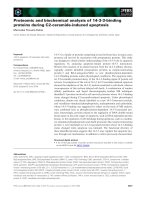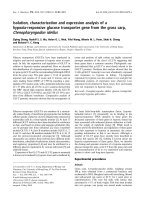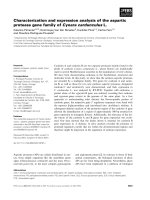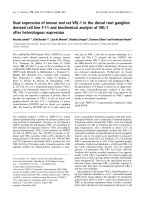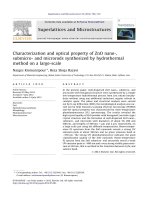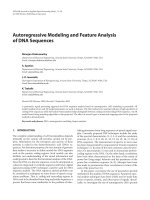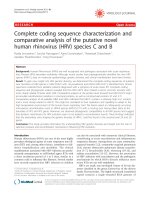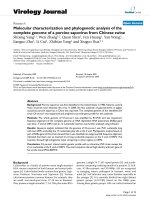Structural characterization and biochemical analysis of ID2, an inhibitor of DNA binding 7
Bạn đang xem bản rút gọn của tài liệu. Xem và tải ngay bản đầy đủ của tài liệu tại đây (945.96 KB, 4 trang )
!
51!
Figure 14: Diagrammatic representation of ID2 HLH structure
(A) Cartoon representation of the overall structure of ID2 HLH showing 2 monomer chains
(chain A in purple and chain B in brown) with α-helices labeled as α 1 and α2 linked by a loop
(green). Potassium ion is shown in grey.
(B) Top view (90° forward rotation) of ID2 HLH looking from the N-terminal downwards shows
an acetate molecule
(C) Acetate molecule likely contributed from the mother liquor of Potassium Acetate during
crystallization. 2Fo-Fc map contoured at 1.5σ. Cysteine residues are highlighted with the
distance between them at 15.9 Å to show the unlikely possibility of disulfide bond formation
(D) Potassium ion coordination site showing residues Lys47, Val50, Ile53, and Gln55 with 2Fo-
Fc map contoured at 1.5σ.
!
!
!
!
52!
The overall topology of the ID2 homodimer was similar to other bHLH-containing
proteins such as E47 and MYOD1 and conformed to the same parallel, 4-helix
bundle. The two main differences were the N-terminus and loop regions. The N-
terminus of bHLH-containing proteins contained an extended helix of basic residues
required to bind DNA; the density in this region was not interpretable in ID2 and was
likely disordered. In the loop region of both monomers was density that was too large
to be water. Based on the diameter and the orientation of the charged atoms, a
positive ion was modeled in the density. This was the first report of a loop ion for HLH
structures (Figure 15, grey sphere).
Figure 15: Cartoon representation of the crystal structure of ID2 at 2.1Å resolution showing the
positive loop ion and missing basic region.
!
53!
4.3 Dimer Interface
4.3.1 Hydrophobic Core
The dimer interface was held together by a hydrophobic core consisting of
residues M39, L46, L49, M62, I69, I72, L75 (Figure 16A), all of which had equivalent
buried residues in the structures of E47 (Ellenberger, et al., 1994), MYOD1 (Ma, et
al., 1994) and E47-NeuroD1 (Longo, et al., 2008). An ID3 homology model predicted
about half of the hydrophobic core residues correctly (Wibley, et al., 1996).
4.3.2 Hydrogen Bonds
Besides the hydrophobic core, there were also three inter-chain hydrogen bonds
at Y43.cA-Y43.cB, L49.cA-Q76.cB and Q76.cA-Y71.cB (cA = chain A, cB = chain B)
(Figure 16B). Tyrosine-43, which was conserved in the ID3 NMR structure, was
hypothesized to have one protonated and one unprotonated contact. An equivalent
contact for Q76.cA-Y71.cB was found in the E47-NeuroD1 structure at E47.E596-
NeuroD1.Y149 (Longo, et al., 2008). Although Q76 in ID2 formed a shared hydrogen
bond between L49 and Y71 (Figure 16B), the L49 interaction was not conserved; the
closest interaction was Q390-H366 in the E47 homodimer. Instead of hydrogen
bonds at Y43, equivalent positions in E47, MYOD1 and NeuroD1 contained
hydrophobic residues that formed part of the hydrophobic core. Hence, only the
Q76.cA-Y71.cB hydrogen bond was conserved in the E47-NeuroD1 heterodimer.
To assess the importance of this conserved hydrogen bond in ID2 heterodimer
formation, site directed mutagenesis was done on Y71 and Q76. Single mutations to
change the size and charge of the residues were Y71A, Y71F, Q76A and Q76D
(Table 5). Since these interactions were not found in any of the non-ID homodimers
(only in the E47-NeuroD1 heterodimer), it was expected that mutations at these sites
were not important for homodimerization. However, all of these mutations resulted in
the complete loss of soluble protein in Figures 16D and 16E (red arrow shows
!
54!
expected band location based on previous gel experiments). It was inferred that
failure to dimerize led to a failure to fold properly and hence, caused insolubility. This
showed that the hydrophobic core alone was not enough to hold the ID2 homodimer
together; that this hydrogen bond was critical to ID2’s structure. Secondarily, it
implied that the monomer was either not stable on its own or more prone to
degradation.
In addition to the inter-chain hydrogen bonds, there was one intra-chain hydrogen
bond at K61.cAα2 and N40.cAα1 in ID2 (Figure 16B). This interaction was only seen
in chain A of ID2 at 3.1Å and chain B of the ID3 (Q66 – N45) NMR structure at
around 3.8Å. Because the distances in the models were on the boundaries of a
hydrogen bond, it was thought to be unlikely to play a role in homodimerization.
However, the asapargine residue was highly conserved at a sequence level and
found in all Human IDs, E47 and Mouse E47 and NeuroD1 whereas the lysine in ID2
was a glutamine in ID3 at equivalent positions (Figure 19). Therefore K61 was
mutated in ID2 and Q66 was mutated in ID3 to alanines to test for effects on
homodimerization.


